Trees are incredible beings no matter where you are in the world. Arctic trees have to really want to be where they are to exist in those harsh conditions. It’s no summer camp in the Arctic. It’s a rough atmosphere where very little can survive. Within the Arctic Circle, the annual median temperature is between 0-20° degrees Fahrenheit. The coldest days in the Arctic tundra can reach -94° Fahrenheit. It has historically been 90.5° Fahrenheit during the warmest days below the treeline, as recorded in June 2022. That exceptionally high temperature is due to global warming and will likely continue to break records.
The high temperatures that the Arctic is increasingly seeing have allowed invasive trees to move in. The trees are not necessarily invasive to the Arctic, in general. However, they are invasive to the delicate ecosystem that is the Arctic tundra. This is not good news for the Arctic, specifically the treeless Northern Arctic, and as the climate continues to warm, the snowy landscape of the Northern Arctic is fading away to green, grassy meadows.
Caribou are one species that needs the snowy tundra to survive. In nature, when any flora or fauna goes extinct, everyone on Earth feels the trickle-down effects. Species die out when a specific tree habitat or source of nourishment declines rapidly. We may not feel severe climate change effects where we are in the world, but it is going to catch up with the severe damage already being seen in the Arctic tundra one day very soon.
Scientists have said that the treeline has crept forward about a centimeter at a time every year. Now, the trees, specifically the downy birch, are bounding ahead at 40 meters a year. This is a tree native to the Arctic, just not at the rate that it’s currently growing and accelerating. Global warming is causing the Arctic to warm up four times faster than any other place on the Earth. Only time will tell what trees will take over the Arctic and how serious a move this might be for life there.
Fun Facts about Trees
- To figure out the age of a Pine tree, take the trunk’s diameter and divide it by 2.5 to get your answer. Why 2.5? Because 2.5 centimeters is how much the pine’s diameter grows each year.
- To figure out the age of ANY tree, convert the diameter to inches, multiply the tree species’ growth factor with its diameter, and then the answer is yours!
- In order to properly age a tree using the tree ring system, figure every dark ring means a full cycle of seasons in a year. Add up the dark rings, are you’ve found the tree’s age.
- Petrified wood is illegal to have because it is federally protected as a fossil.
- Trees are able to communicate and defend themselves against attacking insects.
- The Coulter pine in California yields a 10-pound pinecone!
South Facing Slopes & Southern Arctic Trees At or Below the Treeline
1. Basalm Fir
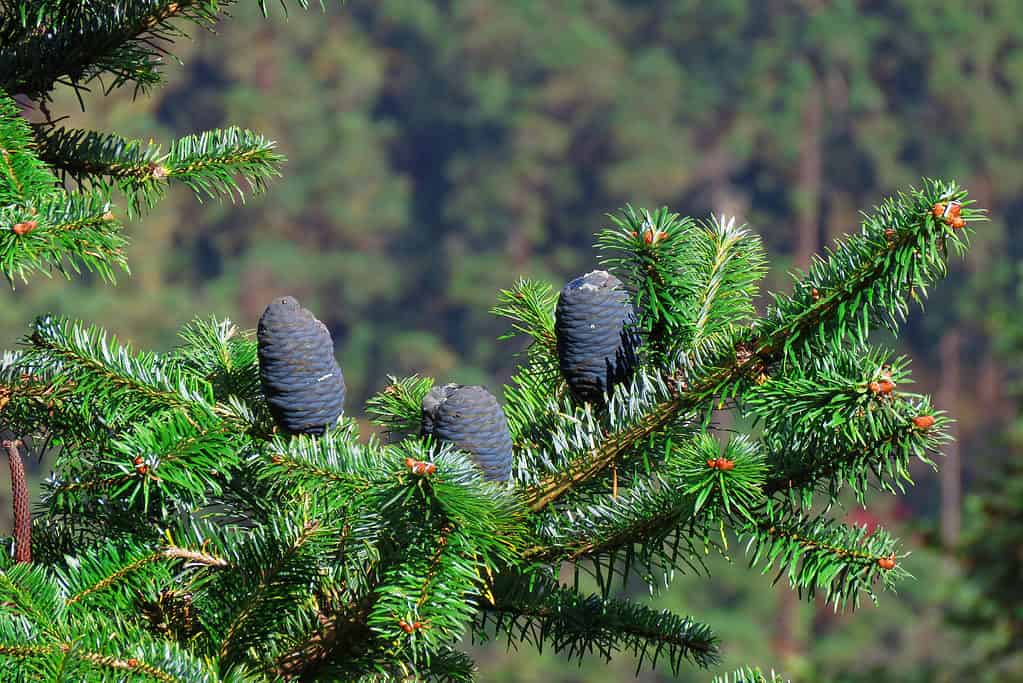
Balsam fir with greyish, soft cones.
©Nature Clickz/Shutterstock.com
Family: Pinaceae
Scientific Name: Abies
Size: 33-262 feet tall
Trunk Diameter: 1 foot 8 inches up to 13 feet
Characteristics: Thick needles attached to the branch that also bears small soft pinecones
Type of Forest Found: Coniferous
Fir trees are in the evergreen cone-bearing family and are part of forests that make up coniferous trees. These slow-growing trees start with smooth bark that becomes rough with age. Some of these trees can live to be 500 years old! They drop winged seeds from their densely needled branches onto the coniferous forest floor.
2. White Birch

White birch trees were among the first to be discovered when the glaciers receded.
©iStock.com/Chantale Ouellet
Family: Betulaceae
Scientific Name: Betula pubescens
Size: 60 feet tall
Trunk Diameter: 1 to 2 feet
Characteristics: Pointed leaves that are 2 inches long and a papery-looking trunk
Type of Forest Found: Deciduous
The white birch has many names and is commonly called the paper birch. The appearance of the tree’s trunk looks like torn and flaking paper falling away from the tree. This tree is also called the downy birch for its hairy-like leaves. White birch is a popular wood for creating furniture. These trees thrive in the colder upper northern hemisphere.
3. Larch
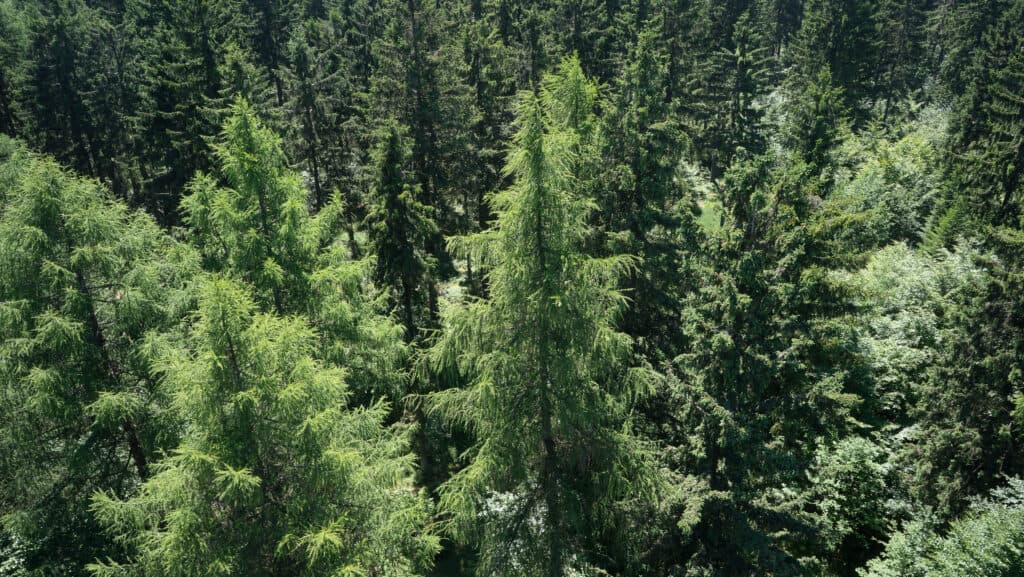
Larch trees have resinous and very tough timber.
©iStock.com/Hopfphotography
Family: Pinaceae
Scientific Name: Larix
Size: 65-150 feet tall
Trunk Diameter: Approximately 24 inches
Characteristics: Deciduous bunches of bright green needles and small, two-inch, soft cones make up this softwood tree
Type of Forest Found: Coniferous
The larch tree has many uses in the lumber trade. The resin from the wood can be made into turpentine, and the wood itself is excellent for making small items like snowshoes and large items like furniture. These trees are pushing further north than ever before as the Boreal forest outside of the Arctic Circle continues to grow with global warming. The trees can survive very cold and harsh conditions but need humidity to thrive.
4. Aspen
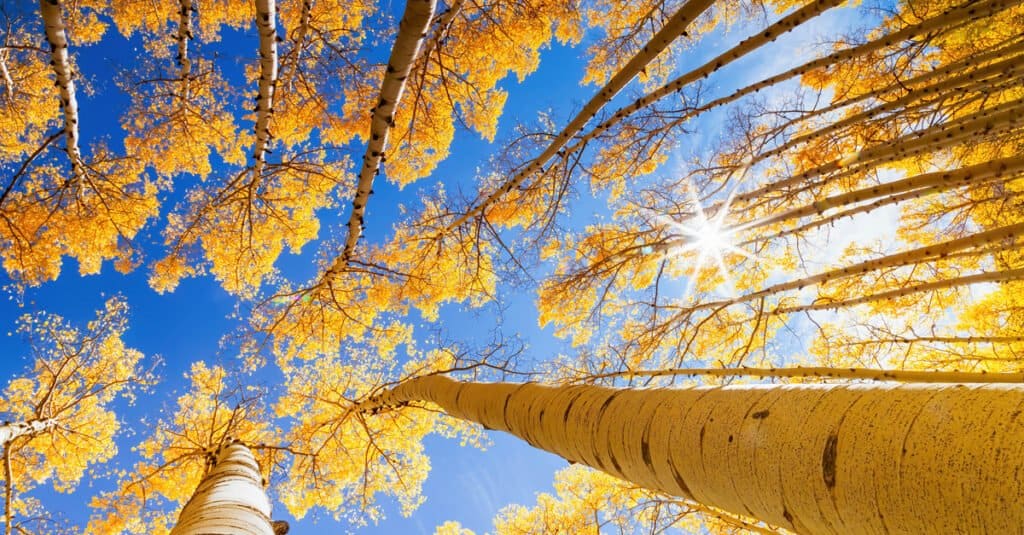
Aspen trees are deciduous, meaning they drop their leaves before winter every year.
©Pritha_EasyArts/Shutterstock.com
Family: Salicaceae
Scientific Name: Populus
Size: 20-80 feet tall
Trunk Diameter: 3-18 inches
Characteristics: Small heart-shaped leaves with rough greyish-green or white bark
Type of Forest Found: Coniferous forests but is a Deciduous tree
Aspen wood is white and soft. These trees prefer to grow in coniferous forests without other deciduous trees. These incredible trees are able to survive wildfires because their unique root system lies low enough underground that the heat from a fire does not kill the roots. Aspen trees need a lot of sunlight to grow; in the right conditions, they can grow up to two feet a year! Their ability to survive harsh winters goes hand-in-hand with their ability to drop their leaves before winter like other deciduous trees.
5. Alder
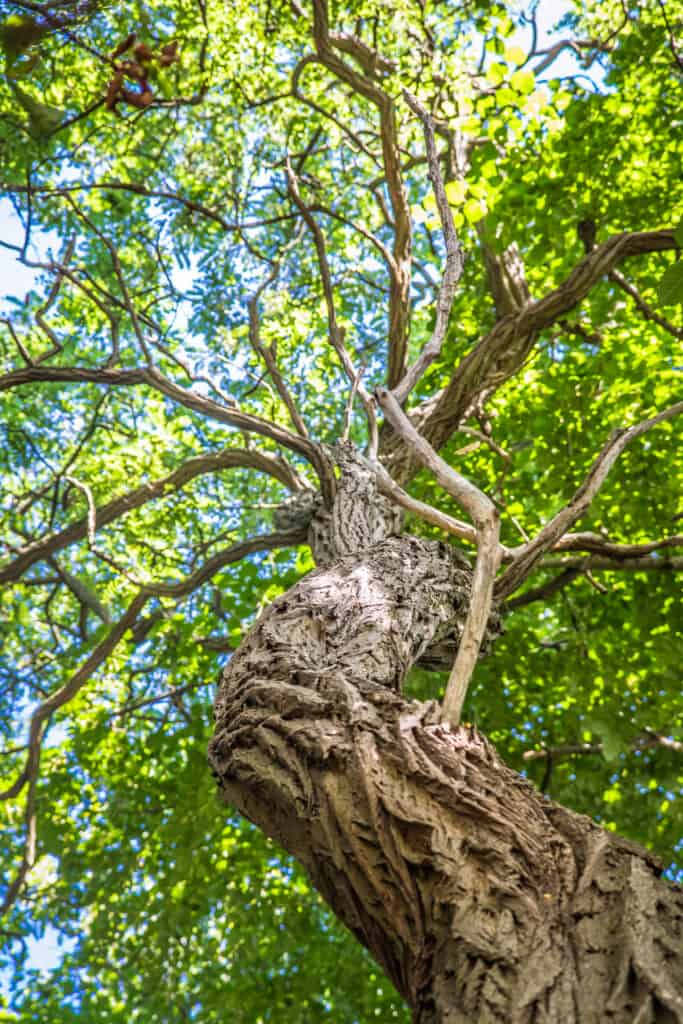
Alder tree (Alnus glutinosa) with its crooked branches
©Aleksandra Duda/Shutterstock.com
Family: Betulaceae
Scientific Name: Alnus
Size: 66-100 feet tall
Trunk Diameter: 14-18 inches
Characteristics: Wood-like cones that darken in the winter, rough bark, and round leaves with a serrated edge
Type of Forest Found: Deciduous
Alder trees, which are in the same family as birch trees, prefer moist soil near waterways or natural drainage systems. With the proper setup, the alder tree can live 100 years, which isn’t very old for a tree. Even though the alder tree loses its leaves every winter, the cylindrical cones remain throughout the winter. This is because the cones developed from clusters of conifer flowers called catkins, giving the tree a winter wonderland look throughout winter. Some alders are also used as hedge shrubs for landscaping.
6. Oak

White oak trees (pictured) get their name from the white color found on newly cut wood.
©ForestSeasons/Shutterstock.com
Family: Fagaceae
Scientific Name: Quercus alba
Size: 50-100 feet tall
Trunk Diameter: 24 inches
Characteristics: Large lobed leaves with deep crevices throughout the rough greyish-brown bark
Type of Forest Found: Deciduous
The oak tree is one that just about everyone knows and can point out. There are many different types of oak trees, each with its own set of characteristics. The live oak tree is only seen in the southern United States in warm, humid climates near water. The branches twist and turn to form the tree into a vast, sprawling, low heavy-branched masterpiece. The bark of an oak tree has many medicinal properties, from inflammation to toothache. All oak trees can outlive many in the forest and reach 600 years old. Oddly enough, the first oaks came from the Arctic and spread southward. Oak trees can not be found in the Arctic tundra, but they are plentiful below the treeline of the Arctic Circle.
7. White Ash
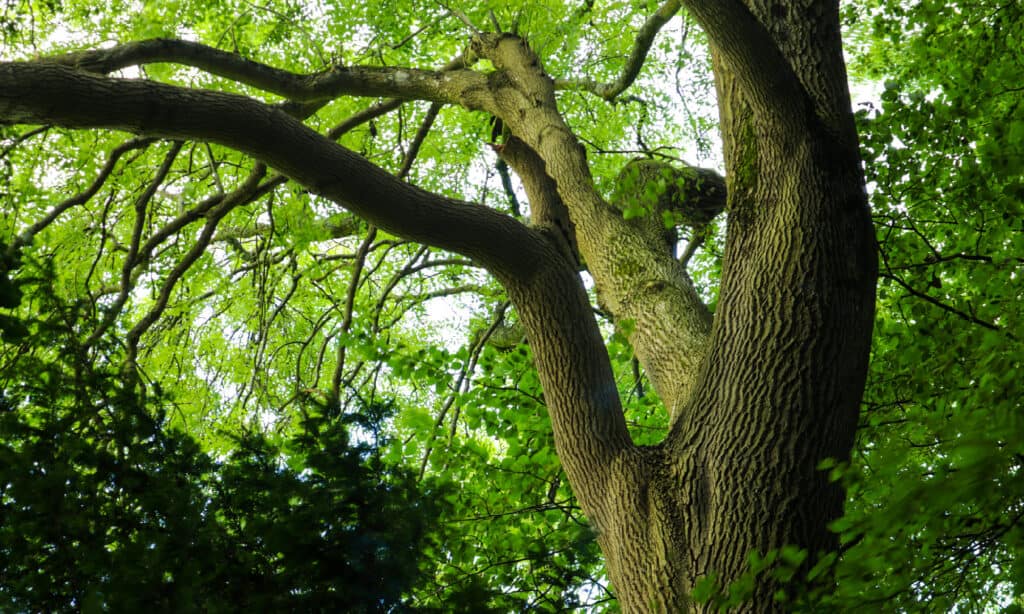
The white ash is a species of ash tree native to eastern and central North America.
©iStock.com/Alex Montacute
Family: Oleaceae
Scientific Name: Fraxinus
Size: 50-80 feet tall
Trunk Diameter: 24 inches
Characteristics: Hardwood, rough bark, twisted angular branches, and a large crown
Type of Forest Found: Deciduous
White ash trees are a hardwood that many use to make guitars, furniture, and other fancy trinkets. Ash trees can be massive with a huge crown of twisted branches giving the tree a creepy look in winter. They are beautiful and often drawn in stories depicting trees. They also make excellent trees for swings and climbing. The bark of a white ash tree is covered with deep chasms and rough peaks. This tree has excellent shade coverage. The emerald ash borer is the main culprit in the destruction of these majestic trees. This highly invasive insect has traveled all over the world to the places where ash trees were once abundant. One way the ash tree fights back is by growing in extremely cold environments, where the beetle borer cannot exist.
8. Elm

Elm trees are incredibly hardy and able to grow worldwide.
©iStock.com/skymoon13
Family: Ulmaceae
Scientific Name: Ulmus glabra
Size: 80-130 feet tall
Trunk Diameter: Over 70 inches
Characteristics: Light or dark grey bark, the leaves are symmetrical oblongs with double serrated edges
Type of Forest Found: Deciduous
There are over 30 species of elm ornamental shade and forest trees worldwide. Elm trees are incredible in more ways than one. These trees grow anywhere and everywhere, from the Arctic Circle all the way to South America. They can be ignored entirely after planting and grow on average three to six feet a year. Native Americans use slippery elm to make salves to treat wounds and boils. Orally, they are used to treat ulcers, coughs, sore throat, and diarrhea.
9. Hornbeam
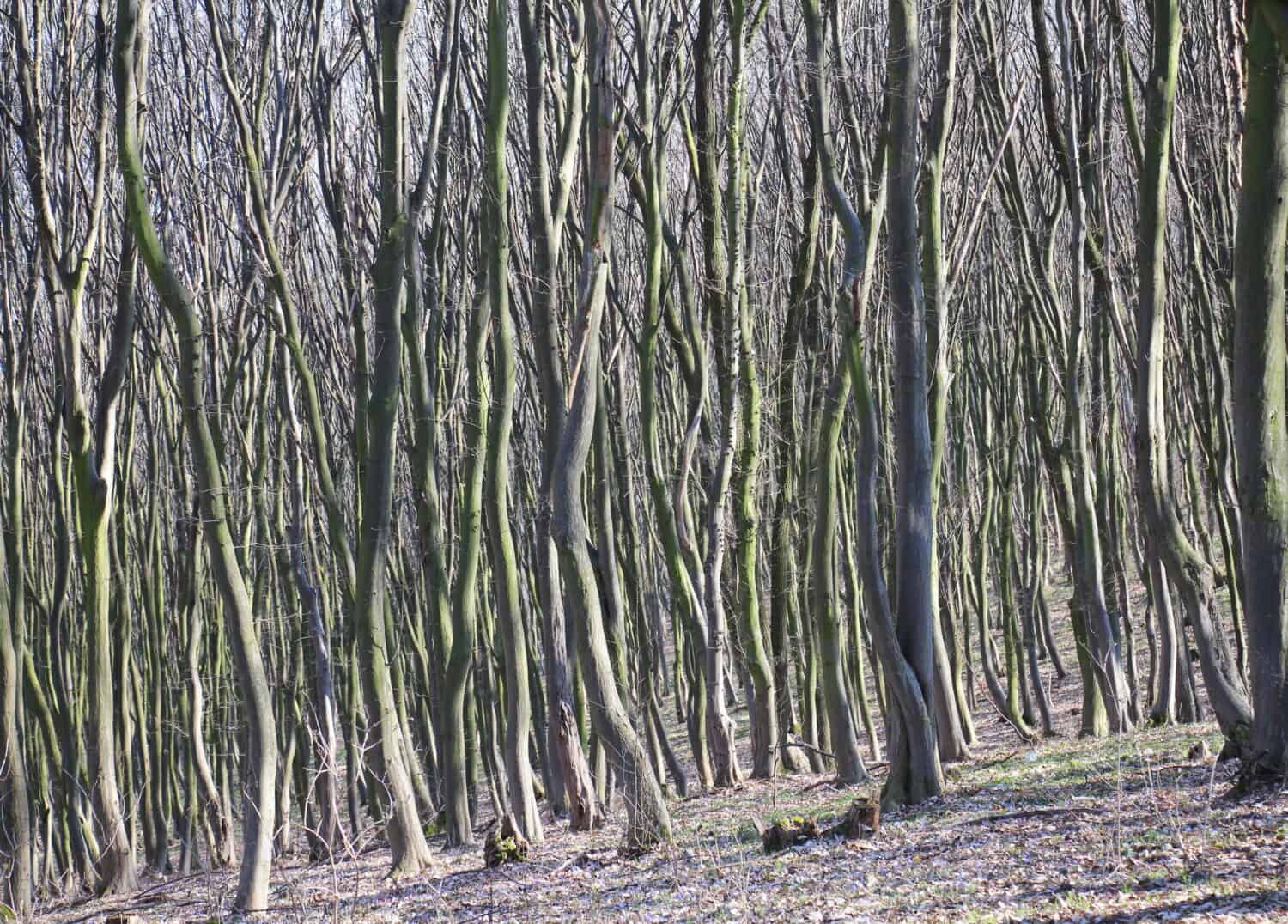
Hornbeams are very slow-growing deciduous trees.
©Orest lyzhechka/Shutterstock.com
Family: Betulaceae
Scientific Name: Carpinus caroliniana
Size: 20-40 feet
Trunk Diameter: Typically a foot wide or more and has more than one trunk
Characteristics: Dark green sawtooth-edged leaves, light-brown nutlets that hang in clusters and mature in October
Type of Forest Found: Deciduous
The wood of the hornbeam tree is called muscle wood because of its sinewy-like texture; the wood is very strong, and the truck is fluted like a muscle. Early Americans used this mega-strong wood to make bowls, tool handles, and ox yokes. The hornbeam tree grows at a pace of around a foot per year and reaches 20-40 feet tall between 50-150 years. This little tree is almost as wide as it is tall at 20-30 feet wide. The hornbeam is peculiar in that the old dead leaves do not fall off before or during winter, but when spring arrives, their replacements grow, which is called marcescent.
10. Tamarack
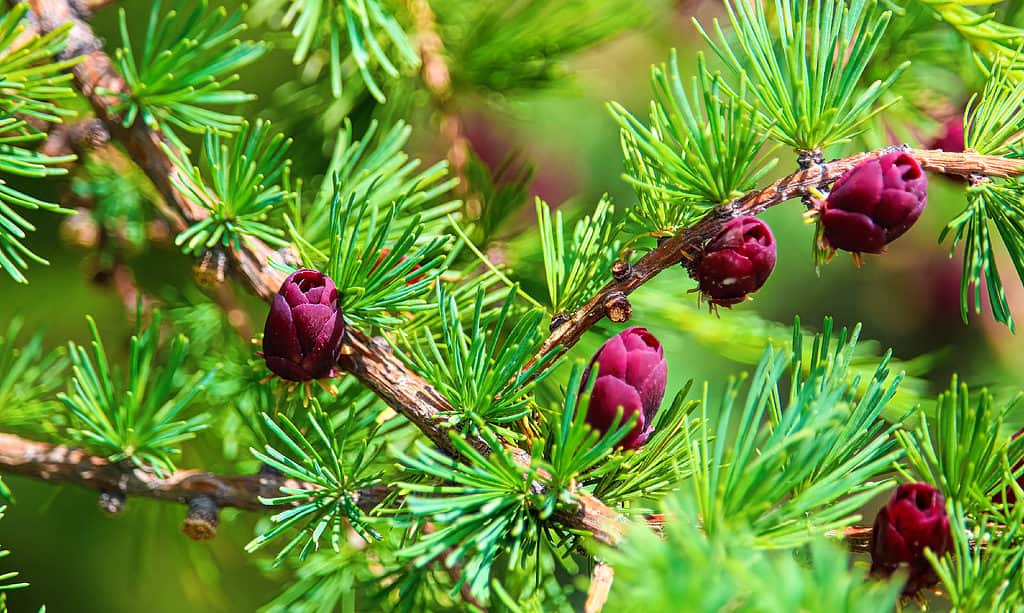
Tamarack cones start pink, then mature to red, and finally brown.
©Amelia Martin/Shutterstock.com
Family: Pinaceae
Scientific Name: Larix laricina
Size: 50-75 feet tall
Trunk Diameter: 12-24 inches
Characteristics: Tiny wooden cones, soft needles that turn golden brown in the fall
Type of Forest Found: Deciduous trees that grow in Coniferous forests
The tamarack tree, sometimes called the Hackmatack tree, often grows in the same area as black spruce trees. The relatively slender tamarack tree has attractive cones that start pink, change to red, and then brown as maturity sets in. The tree can live for 200 years, whereas its cousin, the larch tree, lives up to 400 years. The root system of the tamarack tree is very shallow, condensed, and widespread. They do not require anything too special, although they do need moist, fairly nutrient-rich soil to thrive.
North Facing Slopes & Northern Arctic Trees Above the Treeline
11. White Spruce

©Alexander Varbenov/Shutterstock.com
Family: Pinaceae, also known as the pine family
Scientific Name: Picea glauca
Size: 40-60 feet tall, and the branch spread can be 10-20 feet at maturity
Trunk Diameter: 24 inches
Characteristics: Dark grey-brown scaly bark with short blueish-green needles and small cons
Type of Forest Found: Coniferous
The white spruce tree is a tall, skinny-trunked tree easily recognizable by its needles. It grows at a rate of 12-24 inches per year and can grow in most soil types but prefers sandy, acidic, well-drained, and clay soil. This commonly sought Christmas tree is exceptionally hardy and features slightly curved needles that smell like skunk spray or cat urine when crushed.
12. White Pine
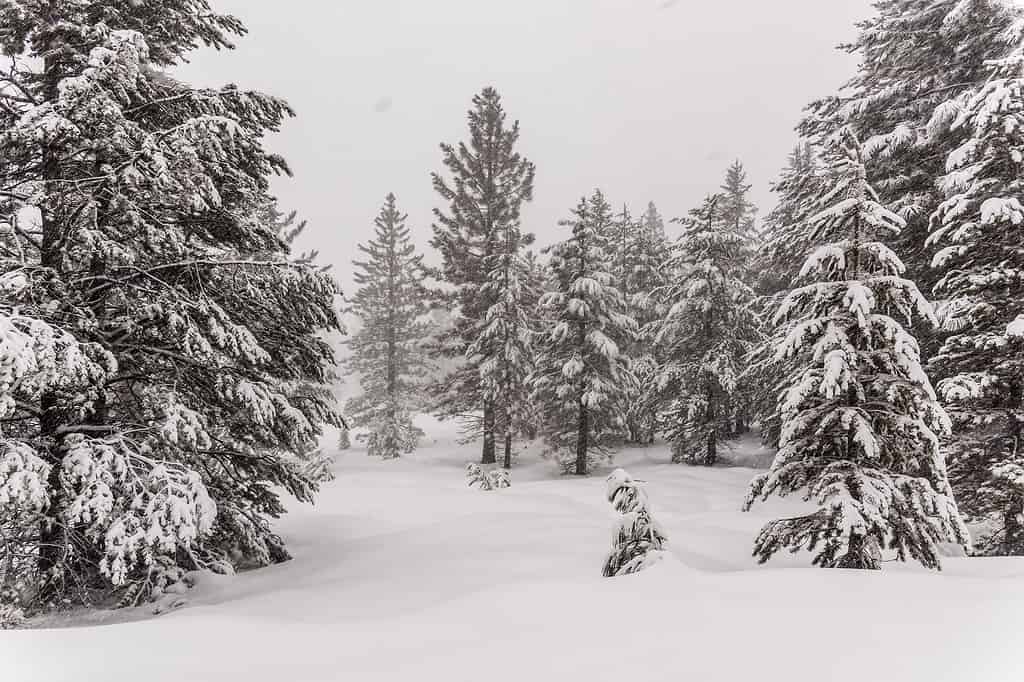
White pine trees sag under the burden of heavy snow during a snowstorm.
©iStock.com/Bill_Dally
Family: Pinaceae
Scientific Name: Pinus
Size: 10-250 feet tall though 50-150 feet is the average
Trunk Diameter: 2-4 feet
Characteristics: Tall, slender evergreen that keeps its green 2-4 inch tarry needles year-round, whose bark is smooth and grey, and whose cones are also smooth and contained.
Type of Forest Found: Coniferous
There are over 187 different species of pine trees in the world. The pines within the Arctic Circle tend to grow at a rate of approximately two feet per year. The Iroquois people believe the pine symbolizes peace between nations, groups, or tribes. A pine is a type of evergreen tree, which means the needles and leaves of the tree are “forever green.” The pine does not change the shade of needles in the fall or drop them in the winter. The needles are a permanent fixture on the tree and are known for their fresh “holiday in the snow” smell. The pine is also home to some serious tar inside the hardwood. Because of this, pine is dangerous to burn in woodstoves and fireplaces. The tar residue can build up in the exhaust and cause a fire.
13. Black Spruce
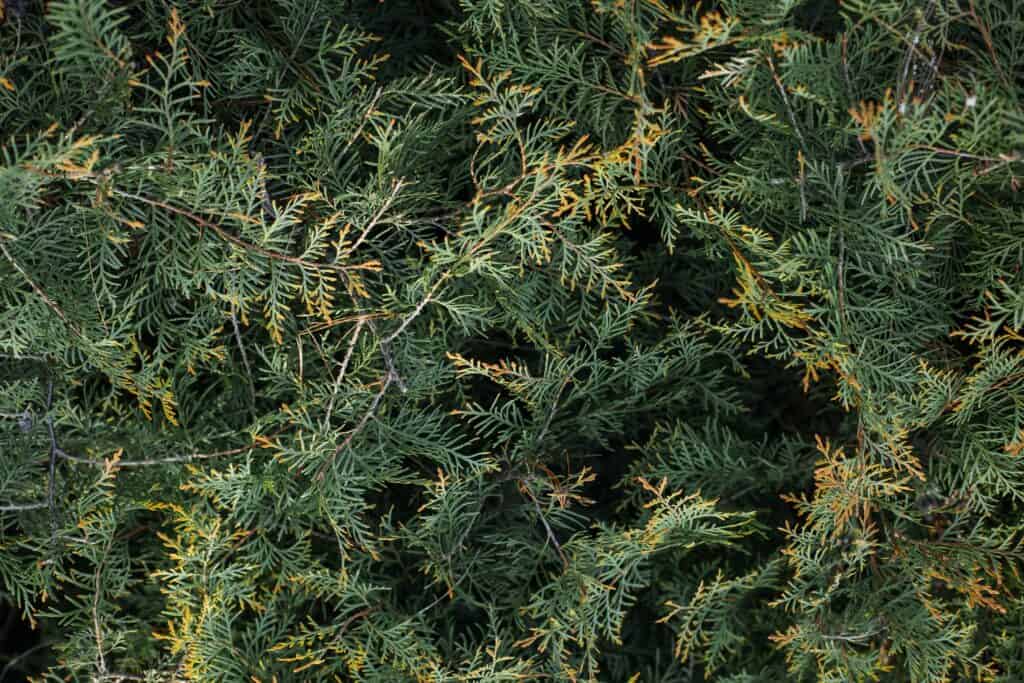
Black Hills spruce has green or purplish female cones and tan to pale red male cones.
©Ua_Biologist/Shutterstock.com
Family: Pinaceae
Scientific Name: Picea mariana
Size: Up to 66 feet tall
Trunk Diameter: 10 inches
Characteristics: Dark four-sided, blunt, short blue-green needles, thin, scaly, reddish-brown bark, and small round cones
Type of Forest Found: Coniferous
Black spruce are commonly used as Christmas trees and have a strong aroma that is frequently used in medicines and beverages. This slow-growing tree gains 12 inches per year at most. Despite being slow growing, this tree is very hardy and can grow in unlikely conditions and be the dominant evergreen in a forest. Its long, descending branches hang heavily facing downward.
14. Artic “Rock” Willow (Salix arctica)
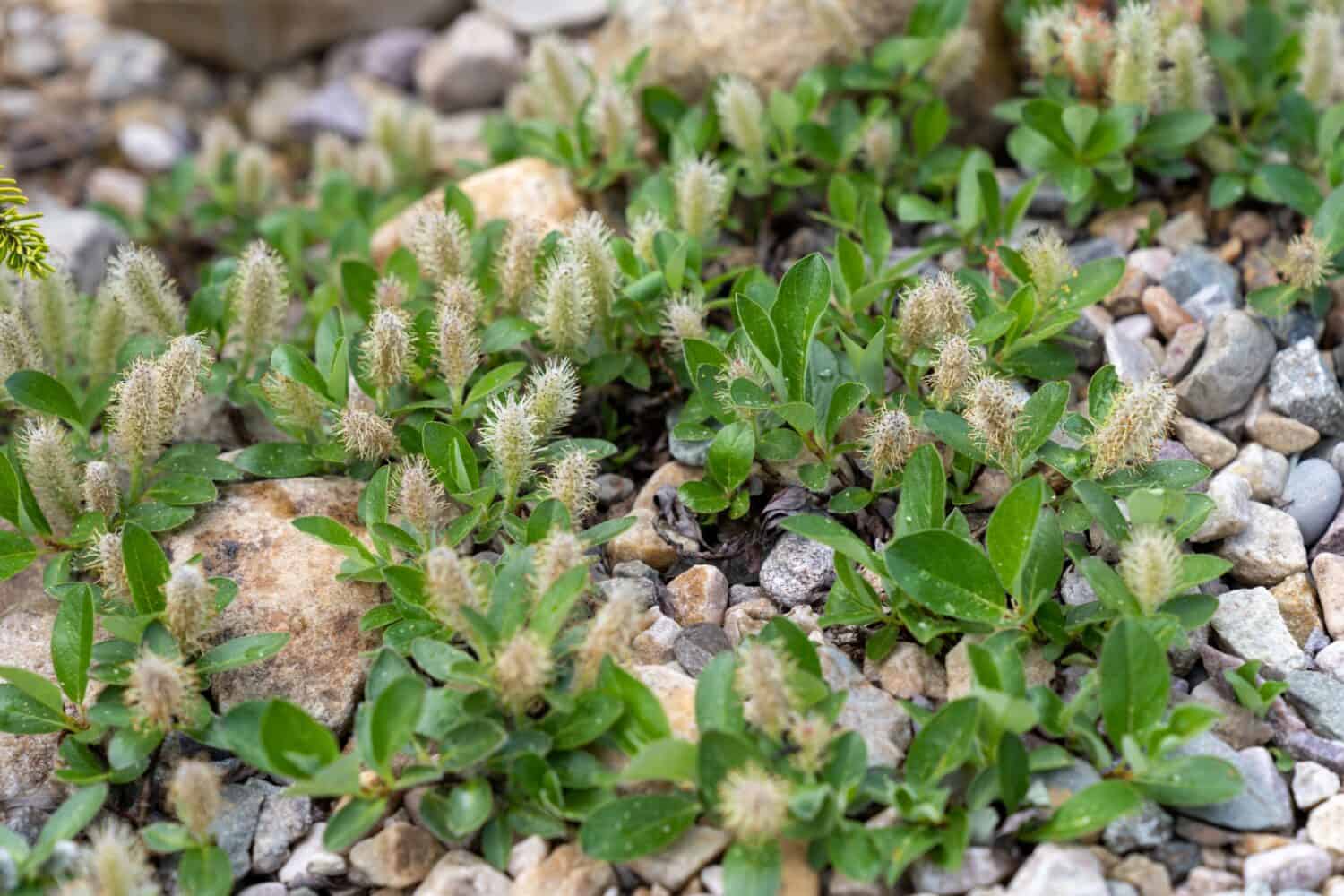
These tiny “trees” are the most abundant plant life in the Arctic tundra.
©melissamn/Shutterstock.com
Family: Salicaceae
Scientific Name: Salix petrophila
Size: 4-8 inches tall
Trunk Diameter: 6 mm
Characteristics: Long, narrow pointed leaves, purplish-red flowers, very short trunk, and branches that grow back into the ground like roots
Type of Forest Found: Coniferous
The rock willow often has long trailing branches like all willows, except these root to the ground wherever they touch. It is one of the most common vegetation types in the Arctic tundra and subzero conditions. These small trees grow in the open throughout the tundra and south of the treeline. They can survive severe conditions and very high altitudes. The rock willow also provides food to many wildlife.
15. Petrified Wood (antarctic)
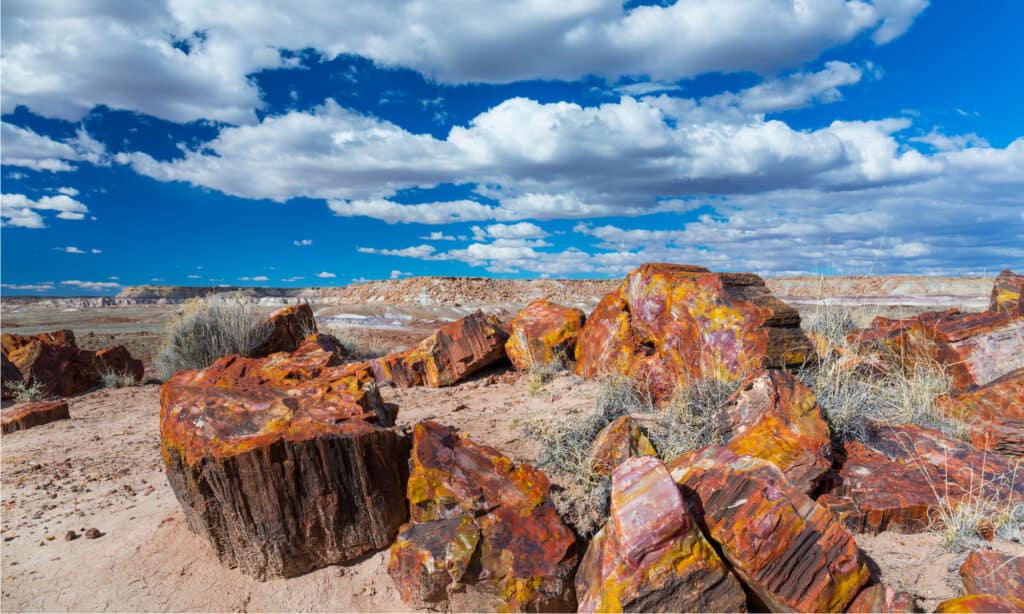
Petrified Forest National Park
©Juan Carlos Munoz/Shutterstock.com
Family: Fossil
Scientific Name: Araucarioxylon
Size: Varies
Trunk Diameter: Varies
Characteristics: Generally, short stone-like remnants colored in amber, brown, grey, or black of an ancient tree that’s over 40 million years old. These can easily be mistaken for strange crystals or rocks by the untrained eye
Type of Forest Found: Coniferous
Over 40 million years ago, the petrified wood forests were formed. These forests form when dead trees become covered with river or volcanic ash sediment and stay rooted in anaerobic conditions. Another way a tree can petrify is if water rich in minerals provides hydration for the trees. The flowing water deposits minerals in the trees as they slowly decompose, which aids and completes the process of turning a living tree into stone.
The photo featured at the top of this post is © Yevhenii Chulovskyi/Shutterstock.com
Thank you for reading! Have some feedback for us? Contact the AZ Animals editorial team.






